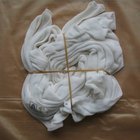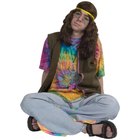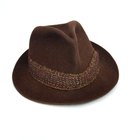
The 1960s were a time of cultural change and tumult, an era that brought us the peace movement, hippie communes and sweeping trends in music, art and fashion. The styles that began on the streets of Haight-Ashbury soon spread, with bell-bottoms and tie-dyed shirts seen on youth around the country. Dubbed Bohemian style, hippie dress and psychedelic wear, this free-spirited fashion clothing continues to remain fresh and creative today.
Psychedelia Defined

Rejecting the consumerism of mid-century America, youth embraced psychedelic clothing as a creative reflection of the changing culture. Considered rebellious, unconventional and anti-establishment, psychedelic clothing style design can be seen in fur-trimmed vests, wide bell-bottom denim trousers, flowing caftans and floral embellishments, used on both men’s and women’s garments. Characteristic features of psychedelic clothing include intense vivid color and swirling abstract patterns.
Tie-Dye Rocks

Fashionable hippies, eager to reject mass-market clothing, began tying off sections of fabric in random patterns using string and rubber bands. The cloth was then hand-dipped into pots of colored fabric dye, producing a unique, multicolored T-shirt, dress or scarf. The popularity of these artistic, kaleidoscopic designs spread rapidly, and tie-dyed fashion was born. The well-dressed hippie took care to accessorize the look, with both genders adding headbands, beads, fringed shawls and ethnic jewelry.
Art Meets Music Meets Fashion

Rock music exerted a powerful influence during the subversive '60s, and musicians served as role models for psychedelic fashion trends. Rock ‘n’ roll album cover art was featured on tees, along with the iconic peace symbol and groovy flower-power imagery. Pop Art inspired colorful, vibrant fashion design, as did underground comics and poster images.
Still Groovy After All These Years

Multicolored hues, optical design effects and imaginative images continue to find their way into contemporary fashion. Custom creative attire with a funky, free-spirited vibe owes its fashion provenance to the heady days of the 1960s. While sometimes parodied,vestiges of the Age of Aquarius’ psychedelic clothing continue to be embraced today by enthusiasts of Bohemian and vintage styles.
Related Articles

Hispanic Clothing History

Hat Trends of the Seventies

Zoot Suit vs. Victory Suit

The History of Denim Jackets

Traditional Clothing in Hawaiian Culture

About Apache Indian Clothing

About Tie-Dye

How Did Teenagers Dress in the '60s & ...

What Did Men Wear During the ...

Clothes Worn in the Seventies

Children's Clothes in 1910

Clothing Ideas for a 1970s-Themed Party

How to Wear an 80s Headband

What Kind of Clothing Do People in Mali ...

What Did Men Wear in the '50s?

What Kinds of Clothes Do They Wear in ...

1950s Gangster Clothes

Preppy, Boho and Gothic Fashion Styles ...

What Is the Difference between a Coat ...

What Did Kids Wear in the 80s?
References
- Fashion: The Definitive History of Costume and Style, The Smithsonian; Kathryn Hennessey
- Vogue Fashion; Linda Watson
Resources
Writer Bio
Pamela VanderWerf is a writer and editor with experience in public relations, advertising, marketing and journalism. She graduated from Indiana-Purdue University and resides in Los Angeles, where she writes on design, health, consumer issues, fashion, lifestyle and real estate, among other topics.
Photo Credits
Evening Standard/Hulton Archive/Getty Images